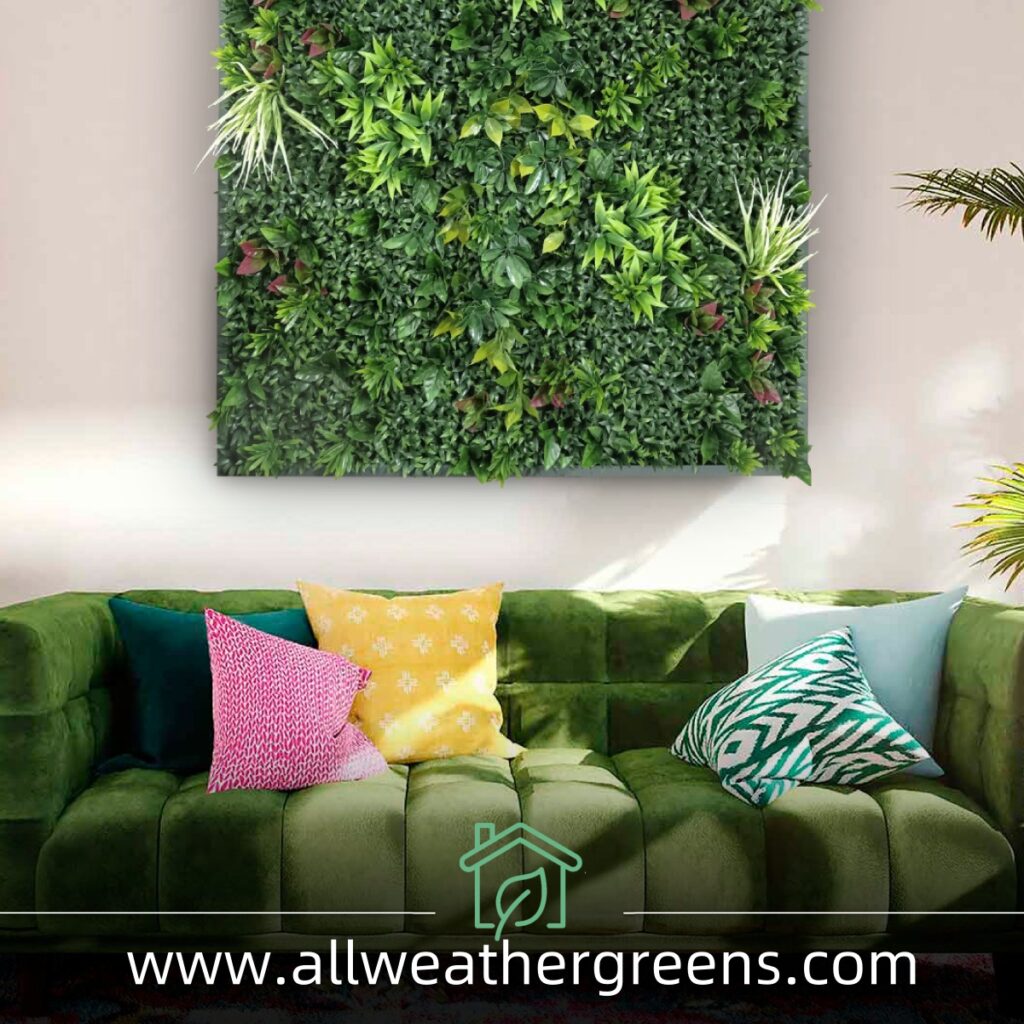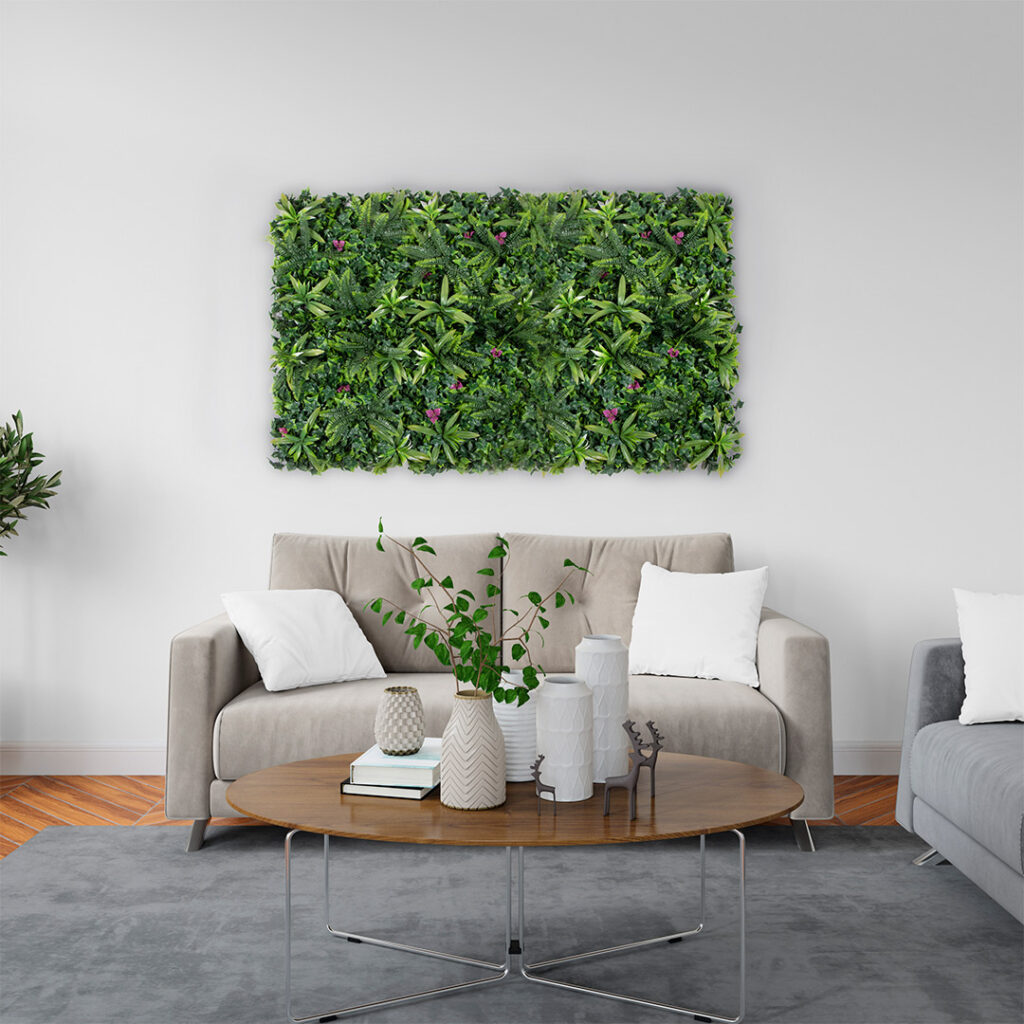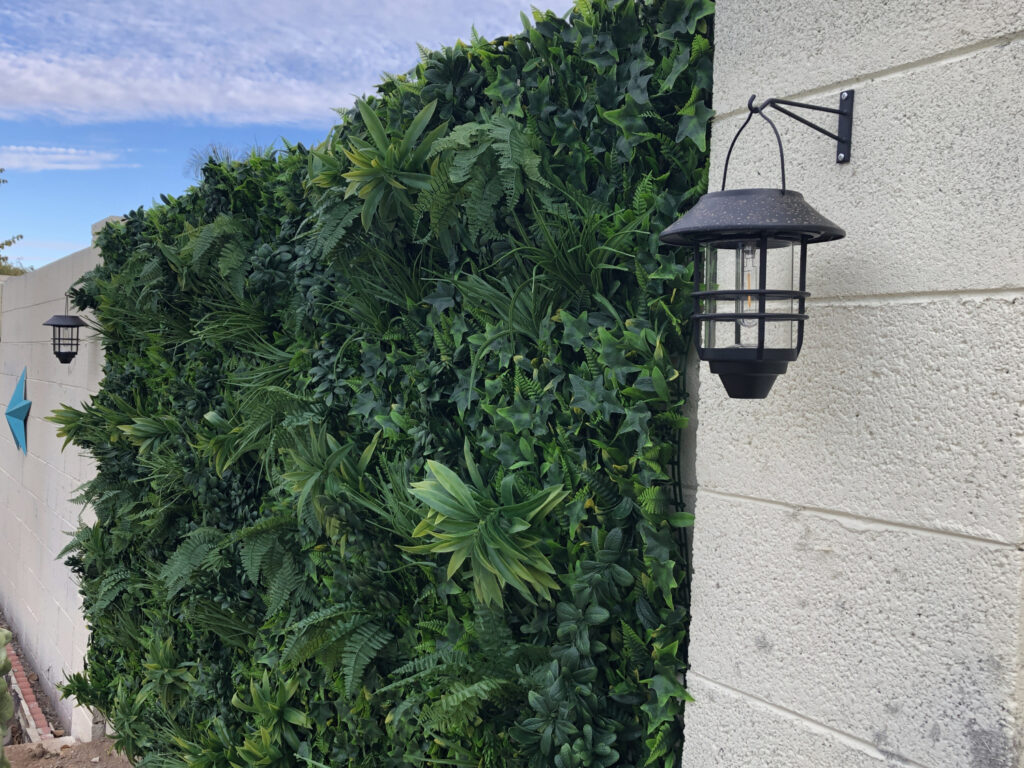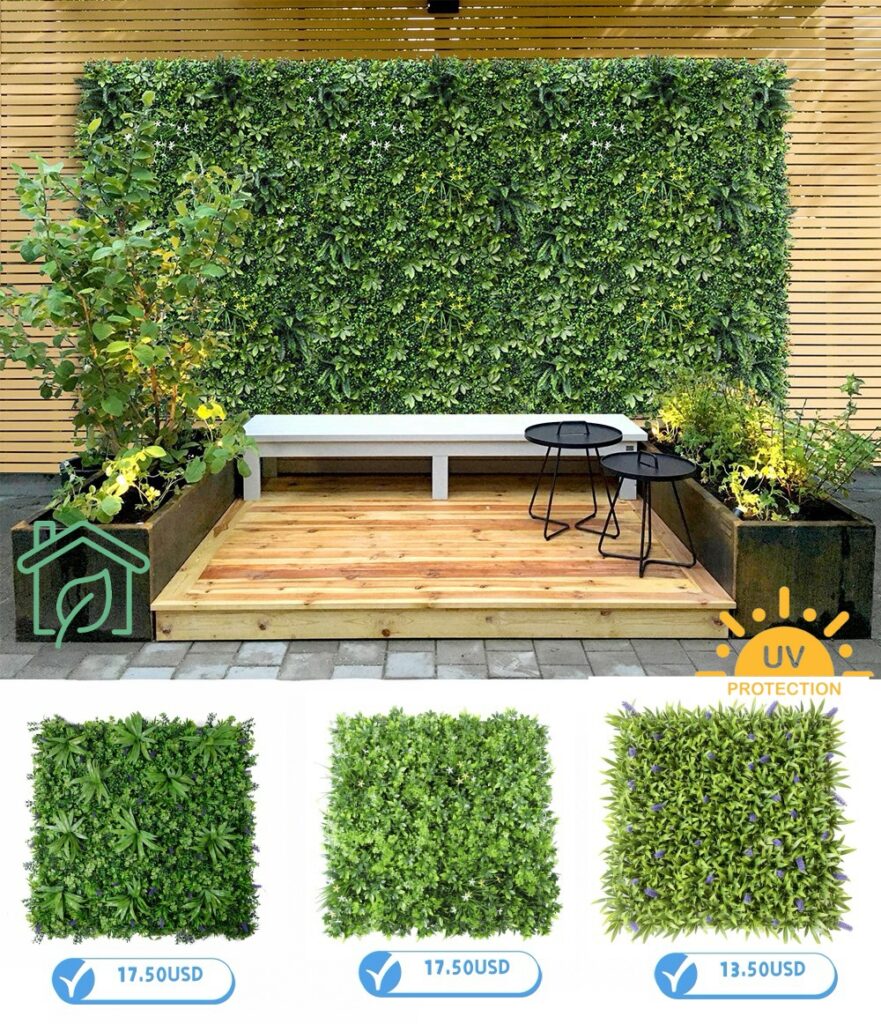Introduction
Artificial green walls, a remarkable innovation in the world of interior and exterior design, have been gaining immense popularity in recent years. These walls, comprised of artificial plants and foliage, offer a unique blend of aesthetic appeal and practical functionality. This article delves deep into the world of artificial green walls, covering everything from their types and benefits to installation processes and maintenance tips.
Understanding Artificial Green Walls
Definition and Overview
An artificial green wall is a vertical garden system made up of synthetic plants and foliage. Unlike their natural counterparts, these walls don’t require soil or constant watering, making them an excellent alternative for spaces where traditional gardening is challenging.

History and Evolution
The concept of green walls dates back centuries, but the adaptation of artificial elements is a relatively recent development. This section explores the journey from natural to artificial, highlighting key innovations and changes over time.
Types of Artificial Green Walls
Indoor Artificial Green Walls
These are designed specifically for interior spaces, considering factors like indoor lighting and aesthetics. They can be found in homes, offices, and commercial spaces, adding a touch of nature without the upkeep of real plants. there is also Fire-resistant grass wall panels recently and please check the below link for know more FR Grass wall collection. https://www.linkedin.com/feed/update/urn:li:activity:7127927573061271552/
Outdoor Green Walls
Outdoor artificial green walls are built to withstand various weather conditions. They are often used in urban settings to enhance the visual appeal of buildings and outdoor spaces.
An outdoor artificial green wall is typically made from high-grade, durable polyethylene or polyurethane. These materials are chosen for their resilience and ability to mimic the texture and color of real plants. Each leaf, stem, and flower is crafted to reflect the intricate details of natural foliage, from the delicate veins in a leaf to the subtle gradients of color in petals.
UV Resistance
UV resistance is a critical feature of these artificial greens. The materials are infused with UV inhibitors during the manufacturing process. These inhibitors act as a protective shield, absorbing or reflecting harmful UV rays, thus preventing the colors from fading and the material from becoming brittle over time. This ensures that the wall retains its lush, vibrant look for years, even when installed in locations that receive direct sunlight for the majority of the day.
Customizable and Modular Options
The versatility of artificial green walls lies in their customizable nature. This section discusses the various options available for personalization, from different plant types to modular systems that fit various spaces.
Benefits of Artificial Green Walls
Aesthetic Appeal
One of the primary attractions of artificial green walls is their aesthetic value. They can transform dull walls into vibrant spaces, adding color and life to any environment.
Air Quality Improvement
While they don’t purify the air like live plants, artificial green walls can still contribute to a healthier indoor environment by reducing stress and enhancing overall well-being.
Space Saving and Versatility
Artificial green walls are an excellent solution for space-constrained areas, providing greenery without occupying valuable floor space. They can be installed in various settings, from small apartments to large commercial areas.
Low Maintenance and Durability
Unlike live plant walls, artificial greenery require minimal maintenance and are not susceptible to the same environmental factors, making them a durable and long-lasting option.
Designing an Artificial Green Wall
Planning and Design Considerations
Designing an artificial green wall involves several considerations, including the size of the wall, the type of artificial plants, and the overall aesthetic desired. This section guides readers through the key factors to consider during the planning phase.
Selecting the Right Materials
The choice of materials is crucial for the durability and appearance of the green wall. This part discusses the different types of artificial plants and structures available in the market.
- Polyethylene (PE) and Polyurethane (PU): The majority of artificial green walls are made from high-quality, non-toxic plastics like polyethylene and polyurethane. These materials are favored for their flexibility, durability, and resistance to wear and tear. PE offers a more matte and realistic look, while PU can be molded into intricate shapes and textures, closely mimicking the natural variation found in real plants.
- UV Stabilizers: To ensure the longevity of artificial green walls, especially those exposed to direct sunlight, UV stabilizers are incorporated into the plastic material. These chemicals help prevent fading and degradation caused by ultraviolet radiation, keeping the plants looking vibrant and new for years.
- Wire and Metal Frames: The structure of an artificial green wall often includes a wire or metal frame that provides support and shape to the installation. This framework is designed to be sturdy yet flexible, allowing for custom shapes and sizes. It also facilitates easy mounting on various surfaces, ensuring that the wall can be securely attached to both indoor and outdoor settings.
- Recyclable and Eco-friendly Options: With a growing emphasis on sustainability, manufacturers are increasingly exploring recyclable and eco-friendly materials for artificial green walls. These materials are designed to have a lower environmental impact, both in terms of production and at the end of the product’s life cycle.
Integration with Architecture
Artificial green walls can be integrated into various architectural styles. This section explores how they can complement different design themes, from modern minimalism to rustic charm.
Installation Process
Preparation and Tools Required
Before installation, certain preparations and tools are necessary. This part lists the materials and equipment needed for a smooth installation process.
You will need: 1 Staple Gun + Staples
Step-by-Step Installation Guide
A detailed guide on how to install an artificial green wall, from preparing the surface to attaching the panels and plants.
Step 1: Hold the panel up (make sure it is straight) and move the foliage back to expose the backing mesh.
Step 2: Staple either side of the plastic mesh up the top, on one end.
Step 3: Staple either side of the plastic mesh up the top, on the other end.
Step 4: Continue placing more staples across the panel. We recommend 4 staples across the top and 4 staples every 25cm in a similar way – to make a minimum of 16 staples per 1m x 1m panel.

Safety Measures and Tips
Safety is paramount during installation. This section provides tips and precautions to ensure a safe and effective installation process.
Maintenance and Care
Cleaning and Upkeep
While low maintenance, artificial green walls still require some care. This part covers the basics of cleaning and keeping the wall looking fresh and vibrant.
Long-term Maintenance
Long-term maintenance tips to ensure the longevity and appearance of the green wall over time.
Troubleshooting Common Issues
Common problems that might arise with artificial green walls and how to address them effectively.
1. Color Fading
Problem: Even with UV-resistant materials, prolonged exposure to direct sunlight can cause some degree of color fading over time. Solution: For minor fading, specialized sprays designed to rejuvenate artificial plants can be used to enhance color vibrancy. In cases of significant fading, consider replacing the most affected panels or moving the wall to a location with less direct sunlight. Regularly rotating sections of the wall (if feasible) can also help ensure even exposure and wear.
2. Dust and Dirt Accumulation
Problem: Dust and dirt can build up on the leaves and stems, making the wall look dull and neglected. Solution: Gently dust the wall with a soft brush or cloth. For deeper cleaning, use a handheld vacuum with a brush attachment on a low setting. If the wall is heavily soiled, wiping the leaves with a damp cloth or using a mild soap solution can help. Ensure the materials are water-resistant before applying any liquid cleaning methods.
3. Damage or Wear
Problem: Physical damage, such as tears or broken pieces, can occur due to weather conditions, animals, or accidental impact. Solution: Inspect the wall regularly for damage. Most artificial green walls are modular, allowing for easy replacement of individual panels or sections. If a specific piece is damaged, remove and replace it. For minor tears, use a suitable adhesive (check manufacturer’s recommendations) to repair the damage discreetly.
4. Pest Infestation
Problem: While artificial plants do not attract pests like real plants do, spiders or insects might still build nests or webs among the foliage. Solution: Regularly inspect and clean the wall to prevent pests from settling. Use a soft brush or cloth to remove webs and nests. In case of an infestation, a gentle spray with a hose or applying non-toxic pest control methods can help. Avoid harsh chemicals that could damage the plant materials.
Environmental Impact
Sustainability and Eco-friendliness
Although made from synthetic materials, artificial green walls can be environmentally friendly. This section discusses their sustainability aspect and how they compare to natural green walls in terms of environmental impact.
Comparing to Natural Green Walls
A comparison between artificial and natural green walls, highlighting the pros and cons of each in terms of environmental impact and sustainability.
Cost Analysis
Initial Investment and Installation
Understanding the cost involved in installing an artificial green wall is crucial. This section breaks down the initial investment and installation costs.
Long-term Cost Benefits
Despite the upfront cost, artificial green walls can be cost-effective in the long run. This part analyzes the long-term financial benefits, including savings on maintenance and water bills.
Creative Uses and Applications
Residential Applications
Artificial green walls have various applications in residential settings. This section explores how they can enhance living spaces, balconies, and private gardens.

Commercial and Public Spaces
In commercial and public spaces, artificial green walls serve both aesthetic and practical purposes. This part discusses their use in offices, shopping centers, and public areas.

Innovative and Unique Designs
The potential for creativity with artificial green walls is limitless. This section showcases innovative and unique design ideas that have been implemented around the world. For inspiration, check out www.allweathergreens.com

Challenges and Limitations
Limitations in Design and Appearance
While artificial green walls offer many benefits, there are limitations to their design and appearance. This section discusses these limitations and how they can be addressed.
Environmental Concerns
There are environmental concerns associated with the production and disposal of artificial green walls. This part delves into these issues and how they are being addressed.
Addressing Common Misconceptions
Dispelling myths and misconceptions about artificial green walls is essential. This section addresses common misunderstandings and provides factual information.
Future Trends in Artificial Greenery
Technological Advancements
The future of artificial green walls is shaped by technological advancements. This section explores upcoming trends and innovations in the field of artificial greenery.
Increasing Popularity and Demand
The growing demand for artificial green walls in various sectors is a trend worth noting. This part examines the factors driving this demand and how it is likely to evolve in the future.
Conclusion
Artificial green walls offer a unique blend of beauty, practicality, and versatility. As we have seen, they are not just a design element but a sustainable, low-maintenance alternative to traditional gardening. Their evolving technology and growing popularity suggest a bright future, making them a significant aspect of modern architectural and interior design.
Conclusion
In summary, artificial green walls present an innovative and eco-friendly solution for bringing greenery into various spaces. They combine aesthetic appeal with practical benefits, making them an increasingly popular choice in both residential and commercial settings. As technology advances, we can expect to see even more creative and sustainable developments in this field.
AllWeather Greens: Your Premier Partner in Artificial Greenery 🌿 | Elevating Modern Spaces with Exquisite Artificial Green Walls | Tailored B2B Solutions for Importers, Wholesalers, Architects, Designers, Contractors, Retail Chains, and Beyond. Transform your interiors with our masterfully crafted green spaces, designed for durability and aesthetic excellence. www.allweathergreens.com

